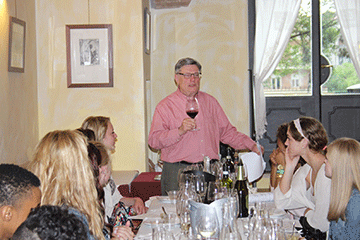News Detail
08/05/2015

If it takes bringing his students into a vineyard in Torgiano, Italy, to help them on their way to becoming world-class journalists and food writers, John C. Hartsock, professor of communication studies at SUNY Cortland, will do that very thing.
“Let me show you the American contribution to fine wine — for better and for worse,” he said from his position kneeling at the base of a grape vine.
“Ah, yes,” their guide at the Terre Margaritelli Winery agreed, with a good-natured laugh and a roll of the eyes.
Hartsock directed the attention of students enrolled in his “Wine Journalism: Telling the Story of Wine” course to the knot of the graft union where the upper European grape vine — the “scion” — joined the American grape rootstock. This is because, he explained, a destructive insect called Phylloxera unknowingly imported from the United States in the 19th century almost wiped out European wine grape vines. These classic varieties were only saved when they were grafted to American rootstock that was immune to the insect.
The 16 students who took Hartsock’s class from May 27 to June 27 also learned about fine wine tasting, the making of wine, the growing of wine grapes and the history of wine.
Hartsock is the author of Seasons of a Finger Lakes Winery, which was awarded a first-place Gourmand Award in Paris in 2011 for wine writing.
His fully accredited course was offered at the Umbra Institute, an American study abroad program in nearby Perugia, Italy, as part of its summer session. Often called a “big university town in a small Italian city,” the institute’s central Italian city setting is ideal for study abroad in Italy, offering fine arts, business and liberal arts courses. Taught as part of the Umbra Institute’s Food & Sustainability Studies Program, Hartsock’s course was organized in partnership with SUNY Fredonia.
“I never thought there could be so much to the study of wine,” said Krystal Vega of New York City, a senior communication studies major at SUNY Cortland.
The class also visited multiple wineries, vineyards, a wine museum and a Tuscan restaurant in Umbria and neighboring Tuscany. The course emphasized the unique features of Umbria, including the active movement in agricultural sustainability, wine making and food studies.
 |
|
| SUNY Cortland professor of Communication Studies John Hartsock demonstrates for his “Wine Journalism: Telling the Story of Wine” class how to sample the merchandize during a visit to an enoteca, or special type of Italian wine shop, in Perugia, Italy. In the above left image, five of his students raise their glass in the vineyards at Terre Margaritelli in Torgiano, Italy. They are, from the left, Jacqueline Niciforo of Long Island University-C.W. Post Campus, Elizabeth Harris of Colorado State University, and SUNY Cortland students Makenzie Morrill, Alyssa Ackerman and Krystal Vega. |
Half the students were enrolled at SUNY Cortland, while the rest came from schools including SUNY Fredonia, University at Albany, University of Wisconsin Oshkosh, Misericordia University, St. Bonaventure University, Long Island University, Colorado State University and Syracuse University.
“I enjoyed learning about how to taste wine,” said Jenna DeLine of Cortland, a junior communication studies major at SUNY Cortland. “This is the first time I’ve learned about how complicated it can be.”
Her sister, Jamie DeLine ’15 of Cortland, arrived in Perugia a sweet wine fan but developed a better appreciation for dry wines. Jamie DeLine has a bachelor’s degree in communication studies from SUNY Cortland and begins a master’s program at Syracuse University’s S.I. Newhouse School of Public Communications in the fall. She said she looks forward to comparing Italian wines to vintages she drank back home. That includes one favorite of hers and her sisters: Red Cat, a sweet red wine made by Hazlitt Vineyards in Hector, N.Y., using the New York-native Red Catawba grapes.
“It will be interesting,” Jamie DeLine said.
Each wine-related tour provided hands-on, real-world examples of issues students might have to cover if they become wine journalists. For example, at the Lungarotti Winery students learned that there are stringent requirements for making sparkling wines.
Every day, for exactly 46 days — not 45, not 47, but 46 days — someone turns thousands of bottles one by one, a quarter turn, a guide told the group. The bottles are turned as part of the “Champagne method” to make the sediment settle in the neck of the bottle for removal.
“My course encourages students to look at wine tasting, making and history as part of a synthesis so they will be prepared to write wine journalism,” Hartsock said. “Nonetheless, students are exposed to diverse opinions that celebrate and debate wine rituals and practices.”
The institute will offer the summer session course again next year.

